
UNDP - HUMAN DEVELOPMENT REPORT 2016 – MOLDOWA. Unequalities in Human Development
Instead of an Abstract/Summary here, please refer to the Introduction PDF-file which includes the Executive Summary. Thank You.
More...We kindly inform you that, as long as the subject affiliation of our 300.000+ articles is in progress, you might get unsufficient or no results on your third level or second level search. In this case, please broaden your search criteria.

Instead of an Abstract/Summary here, please refer to the Introduction PDF-file which includes the Executive Summary. Thank You.
More...
Binarne klasifikacije spola i roda sveprisutne su u našem društvu i utiču na to kako razumijevamo i organiziramo svijet oko nas. Klasifikacija čovječanstva u dvije kategorije – Ž (žensko) i M (muško) – kao i njihova utemeljenost u identifikacijskim dokumentima izlaže kršenju ljudskih prava osobe koje se ne uklapaju u potpunosti u te dvije kategorije. Među njima su interspolne osobe posebno ranjive. Stereotipi koji se vezuju za navodnu dihotomiju roda, kao i za medicinske norme takozvanih ženskih i muških tijela, omogućili su prakticiranje rutinskih medicinskih i hirurških intervencija na interspolnim osobama, čak i kada su takve intervencije kozmetičke, a ne medicinski potrebne ili u slučajevima kada o njima dotične osobe nisu konsultirane niti informirane.Tajnovitost i stid koji se vezuju za interspolna tijela omogućili su da se te prakse odvijaju decenijama, dok se istovremeno problematika ljudskih prava uglavnom nije ni razmatrala. Evropsko društvo do dana današnjeg ostaje u velikoj mjeri nesvjesno stvarnosti koju žive interspolne osobe. Ipak, kroz pionirski rad sve većeg broja interspolnih grupa i pojedinačnih aktivistkinja i aktivista, ljudskopravaške zajednice i međunarodne organizacije postaju sve više svjesne ove situacije i nastoje se suočiti s tom problematikom pozivajući se na standarde ljudskih prava. U maju 2014. godine, Komesar za ljudska prava objavio je Komentar na ljudska prava pod nazivom “Dječak ili djevojčica ili osoba – interspolne osobe nepriznate u Evropi”, u kojem su naglašeni problemi u vezi sa ljudskim pravima s kojima se suočavaju interspolne osobe. Ova tematska publikacija daje detaljnije upute i sadrži preporuke Komesara u cilju rješavanja ove problematike. Publikacija ima svrhu da informira vlasti i praktičare o trenutnim etičkim razmatranjima i ljudskim pravima u ovom smislu, kao i o najboljim globalnim praksama. Prije izrade ovog dokumenta, obavljene su konsultacije sa aktivistkinjama i aktivistima za interspolna prava i medicinskim stručnjacima i stručnjakinjama. Poduzeto je već nekoliko pozitivnih koraka ka razumijevanju situacije u kojoj se nalaze interspolne osobe i u reagiranju na njihove probleme. Nedavno usvajanje međuresorne izjave Ujedinjenih nacija (UN) o sterilizaciji koja tretira i kršenje tjelesnog integriteta interspolnih osoba predstavlja prekretnicu u kombiniranju medicinskog i ljudskopravaškog pristupa. Objavljivanjem izvještaja o interspolnim osobama koji su pripremila nacionalna vijeća za medicinsku etiku povećana je svijest o problemima sa kojima se te osobe suočavaju. Poduzete su i korisne inicijative za zaštitu interspolnih osoba od diskriminacije kroz reforme zakonodavstva koje se odnosi na jednako postupanje. Postoji urgentna potreba za daljnjim napretkom da bi se poboljšala situacija po pitanju ostvarivanja ljudskih prava interspolnih osoba. Ova tematska publikacija ima cilj da potakne razvoj okvira djelovanja sugerirajući dvotračni pristup. S jedne strane, poziva zemlje članice da ukinu medicinski nepotreban tretman “normalizacije” interspolnih osoba kada se on provodi ili propisuje bez slobodnog i potpuno informiranog pristanka dotične osobe. S druge strane, publikacija predstavlja moguće naredne korake u smislu zaštite interspolnih osoba od diskriminacije, adekvatnog priznavanja njihovog spola u zvaničnim dokumentima i pristupa pravdi.
More...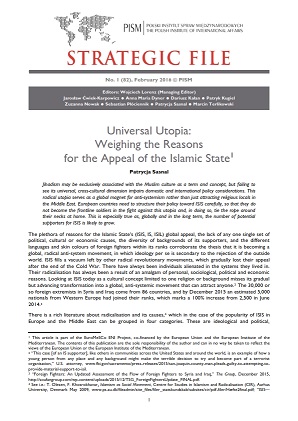
Jihadism may be exclusively associated with the Muslim culture as a term and concept, but failing to see its universal, cross-cultural dimension impairs domestic and international policy considerations. This radical utopia serves as a global magnet for anti-systemism rather than just attracting religious locals in the Middle East. European countries need to structure their policy toward ISIS carefully, so that they do not become the frontline soldiers in the fight against this utopia and, in doing so, tie the rope around their necks at home. This is especially true as, globally and in the long term, the number of potential supporters for ISIS is likely to grow.
More...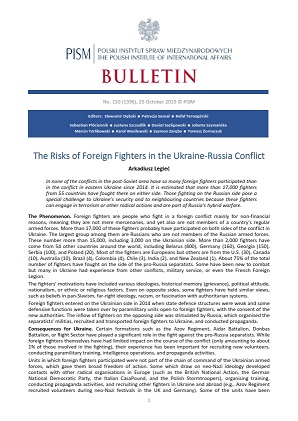
In none of the conflicts in the post-Soviet area have so many foreign fighters participated than in the conflict in eastern Ukraine since 2014. It is estimated that more than 17,000 fighters from 55 countries have fought there on either side. Those fighting on the Russian side pose a special challenge to Ukraine’s security and to neighbouring countries because these fighters can engage in terrorism or other radical actions and are part of Russia’s hybrid warfare.
More...
W żadnym z konfliktów na obszarze postsowieckim nie wzięło udziału tylu zagranicznych bojowników, co w walkach na wschodniej Ukrainie w latach 2014–2019 – szacuje się, że było to ponad 17 tys. osób z 55 państw. Stanowią oni szczególne wyzwanie dla bezpieczeństwa Ukrainy i państw ościennych, ponieważ mogą angażować się w radykalną działalność, także terrorystyczną, oraz są elementem działań hybrydowych prowadzonych przez Rosję.
More...
Seria ataków pakistańskich ekstremistów w Indiach w 2016 r. doprowadziła do kryzysu w relacjach indyjsko-pakistańskich. Wzajemne zarzuty o wspieranie terroryzmu i możliwość kolejnych zamachów stwarzają ryzyko otwartego konfliktu. Rywalizacja ta negatywnie wpływa na współpracę regionalną i stabilizację Afganistanu. Przyczyniła się także do proliferacji broni jądrowej i do wzrostu zagrożeń terrorystycznych. Pokój w regionie zależy głównie od podjęcia przez Pakistan zdecydowanych działań antyterrorystycznych. Jednak bardziej prawdopodobnym scenariuszem jest kontynuowanie stanu kontrolowanych napięć.
More...
Pięć lat po obaleniu Muammara Kaddafiego w 2011 r. Libia jest dziś drugim po Syrii najbardziej zdestabilizowanym państwem arabskim, z wieloma lokalnymi ośrodkami władzy, 2 tysiącami skonfliktowanych bojówek, rozrośniętym przemytem ludzi i rozbudowującymi swoje struktury organizacjami terrorystycznymi: Al-Kaidą i tzw. Państwem Islamskim. Jeśli proces unifikacji władz libijskich pod auspicjami ONZ się nie powiedzie, leżąca zaledwie 450 km od brzegów Europy Libia może w bieżącym roku stać się nowym ośrodkiem działalności dżihadystów (co zwiększy zagrożenie terrorystyczne w Europie) oraz głównym szlakiem migracji, jeżeli droga przez Turcję i Grecję zostanie zamknięta.
More...
The Islamic State’s military offensive constitutes not only a threat to other states of the region, Europe and the United States, but also to Russia. This is down to the potency of the spread of Islamist ideology within the borders of the Caucasus entities of the Russian Federation, and also the latter’s international environment. For this reason, while criticising the American and European policies in the Middle East, Russia is simultaneously in favour of armed activities aimed at the Islamic State, and the Russian authorities are proposing the formation of a new, anti-terrorism coalition under the auspices of the United Nations. Poland should join it only if the U.S. and EU Member States are also going to participate.
More...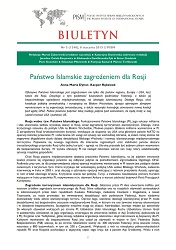
Ofensywa Państwa Islamskiego jest zagrożeniem nie tylko dla państw regionu, Europy i USA, lecz także dla Rosji. Decyduje o tym podatność kaukaskich podmiotów Federacji, a także jej bezpośredniego sąsiedztwa międzynarodowego, na ideologię islamistyczną. Dlatego Rosja, choć krytykuje politykę amerykańską i europejską na Bliskim Wschodzie, sprzyja operacjom zbrojnym wymierzonym w tę organizację terrorystyczną, a także wysunęła koncepcję utworzenia nowej koalicji pod egidą ONZ. Polska powinna poprzeć taką koalicję jedynie pod warunkiem, że będą brały w niej udział również USA i państwa UE.
More...
Da li biste hteli još jedan rat na evropskom tlu? Dobro je počelo. Nakon tri meseca okupiranja administrativnih zgrada u Kijevu i drugim gradovima Ukrajine, grupe demonstranata upale su u nekoliko kasarni i zaplenile pet stotina komada vatrenog oružja. U Lavovu, čitav garnizon se predao i otvorio vrata oružarnice. Na prestoničkom Trgu nezavisnosti počeli su da pucaju.
More...
Mislim da će stanovnici Ukrajine još dugo pamtiti sumorno jutro 19. februara 2014. Požari koji još traju u centru Kijeva, zgarišta od ognjenih barikada kojima su se opozicionari ograđivali od „Berkuta“, miris krvi… Bojim se da je to prvo jutro građanskog rata u Ukrajini. Posle dugog koprcanja, radi rešavanja višemesečnog problema koji ga muči, Janukovič je juče odlučio da primeni nasilnu varijantu. U svom obraćanju građanima, on je za povredu zakona optužio lidere opozicije i na njih svalio svu odgovornost za nasilje i haos koji su juče zavladali ukrajinskom prestonicom. Tokom noćnih pregovora s opozicijom, on je od njih zatražio da se praktično odreknu Majdana. U Kijevu je zatvoren metro, a specijalci su pokušali da zatvore i sve ulaze u Kijev. Pripadnici takozvane unutrašnje vojske, zajedno sa specijalcima, celu noć su pokušavali da sa Majdana rasteraju demonstrante. Odmah ću reći, bez naročitog uspeha. No zato je Dom sindikata, mesto gde je bio štab opozicije, potpuno izgoreo. Prema nekim izveštajima, požar se proširio i na susedne zgrade.
More...
Nebesa se sklapaju nad nama, a sudbina, bog ili anđeo istorije nam se smeju gorko ironičnim smehom. Izrael je po prvi put u paklu ukojem već decenijama žive palestinski građani. Vrtoglavom brzinom Izraelci ulaze u stvarnost poznatu svakom palestinskom detetu.
More...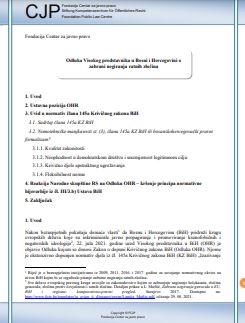
Nakon bezuspješnih pokušaja domaće vlasti da Bosnu i Hercegovinu (BiH) pridruži krugu evropskih država koje su inkriminirale javno propagiranje i promoviranje ksenofobičnih i negatorskih ideologija , 22. jula 2021. godine ured Visokog predstavnika u BiH (OHR) je objavio Odluku kojom se donosi Zakon o dopuni Krivičnog zakona BiH (Odluka OHR). Njome je ekstenzivno dopunjen normativ djela iz čl. 145a Krivičnog zakona BiH (KZ BiH) „Izazivanje nacionalne, rasne i vjerske mržnje, razdora i netrpeljivosti”. Posebno je značajna odredba iz st. (3) kojom se zabranjuje negiranje genocida, zločina protiv čovječnosti i ratnih zločina relevantnih sudova. Bez obzira na činjenicu da Odluka OHR neutralno podstiče kulturu sjećanja u istinitosti i pravednosti4 , te podjednako važi za sve građane BiH, njeno usvajanje proizvelo je suprostavljene političke reakcije.
More...
In this paper, we attempt to build upon existing theoretical and empirical knowledge stemming from criminology, conflict and peace studies, and radicalisation/extremism studies, among others, in order to explore the (potential) role of historical trauma in (collective/group) radicalisation. Historical trauma is objective, altered, or imagined trauma that occurred in the (more or less distant) past and is shared by a group of people (i.e., is one of the markers of their group identity across generations). Radicalisation refers to a process of acquiring more and more extreme political, religious, or social ideologies, and becoming more prone to endorsing any form of (violent) extreme behaviour to achieve one’s goals. The intergenerational transmission of collective trauma can arguably have a significant role in the radicalisation of future generations who consider themselves historically victimized by “the Other”. The aim of this paper is to explore how the intergenerational transmission of collective trauma may contribute to (group) radicalisation. The paper, therefore, introduces a (thus far relatively neglected) intergenerational perspective in radicalisation studies. In order to do so, we first briefly address the existing knowledge on individual and collective radicalisation. Thereafter, we discuss individual and collective trauma and describe their consequences and manifestations. Then, we turn the attention to scholarship on the intergenerational transmission of the legacies of political violence, focusing in particular on the intergenerational transmission of collective trauma, i.e., historical trauma. The final section synthesizes our arguments and makes a couple of (tentative) claims on how historical trauma can potentially contribute to the radicalisation of present and future generations. This paper does not present conclusive evidence nor policy recommendations. Its main aim is to open new doors for further discussions and the future exploration of (violent) radicalisation, trauma, and their intergenerational consequences.
More...
U ovom radu, nastojimo se oslanjati na postojeće teorijsko i empirijsko znanje - koje proizilazi, između ostalog, iz kriminologije, studija sukoba i mira i studija radikalizacije/ekstremizma - s ciljem ispitivanja (potencijalne) uloge historijske traume u (kolektivnoj/grupnoj) radikalizaciji. Historijska trauma je objektivna, izmijenjena ili zamišljena trauma koja se desila u (daljoj ili bližoj) prošlosti i koju dijeli određena grupa ljudi (odnosno, koja predstavlja jedan od markera njenog grupnog identiteta kroz generacije) kroz generacije. Radikalizacija se odnosi na proces u kojem osoba postaje sve ekstremnija u političkim, vjerskim ili društvenim ideologijama, te podložnija prihvatanju bilo kojeg oblika (nasilnog) ekstremnog ponašanja da bi postigla svoje ciljeve. Međugeneracijski prijenos kolektivne traume može nesumnjivo imati značajnu ulogu u radikalizaciji budućih generacija grupa koje smatraju da ih “Drugi“ historijski viktimizira. Cilj ovog rada je istražiti kako međugeneracijski prijenos kolektivne traume može doprinijeti (grupnoj) radikalizaciji? U ovom radu se stoga uvodi (do sada relativno zanemarena) međugeneracijska perspektiva u studije radikalizacije. U tu svrhu, trebamo se prvo kratko osvrnuti na postojeće znanje o pojedinačnoj i kolektivnoj radikalizaciji. Nakon toga, govorimo o pojedinačnoj i kolektivnoj traumi i opisujemo njene posljedice i pojavne oblike. Pažnju onda skrećemo na međugeneracijski prijenos nasljeđa političkog nasilja, sa posebnim fokusom na međugeneracijski prijenos kolektivne traume, odnosno historijske traume. Posljednji dio daje sintezu naših argumenata i predstavlja nekoliko (okvirnih) tvrdnji o tome kako historijska trauma potencijalno može doprinijeti radikalizaciji današnjih i budućih generacija. U ovom radu se ne izlažu konačni dokazi niti ultimativne preporuke za politiku. Glavni cilj rada je da otvori nove prostore za dalje rasprave i buduća istraživanja (nasilne) radikalizacije, traume i njenih međugeneracijskih posljedica
More...
Tokom okupljanja krajnje desnice na Svjetskom kongresu porodice u Italiji 2019. godine ultrakonzervativni španski aktivist je izjavio: „Ovaj kulturni rat je globalni rat. Neprijatelji su se infiltrirali u sve institucije, od političkih partija do Ujedinjenih nacija. Ali, trendovi se mjenjaju i sada moramo pokrenuti globalne kampanje u prekograničnom ultrakonzervativnom odgovoru. Moramo preuzeti vlast, direktno ili indirektno, ‘kontroliranjem okruženja’ u kojem djeluju političari.“ Te iste godine, obraćajući se Generalnoj skupštini Ujedinjenih nacija, generalni sekretar UN-a Antonio Guterres naglasio je potrebu za odgovorom na aktualno „protivljenje ženskim pravima“, ističući da svi trebaju „skretati pažnju na uznemirujuće zajedničko obilježje terorističkih napada i ekstremističkih ideologija: nasilnu mizoginiju počinilaca“. Iako oba govora izazivaju strah i oprez, u samo jednom je javno opisan neprijatelj. Mobilizacija nacionalista nakon političkih uspona krajnje desnice i autoritarnih režima u zemljama istočne i zapadne Evrope, i širom svijeta, izrodila je nove oblike ekstremističkih narativa okupljene oko tradicionalnih i vjerskih ideologija, u kojima rod ima važnu ulogu i gdje rasprave o rodnim normama, pitanjima i politikama imaju značajan uticaj na političku mobilizaciju. Rasprave o pobačaju, planiranju porodice, „prirodi“ žena i muškaraca, seksualnom obrazovanju u školama, rodnim studijama na univerzitetima i položaju seksualnih manjina, slijede linije političkih podjela - s krajnjom desnicom na jednom kraju spektra. Evidentno je da su stavovi i kapaciteti desnice ugrađeni u nove nacionalističke politike i retoriku, kao i u populističku i ekstremističku mobilizaciju pod krinkom antifeminističkog narativa. Dominantni desničarski diskurs da su muškarci ugroženi nastojanjima da se uspostavi rodna ravnopravnost doveo je do uspona novih oblika patrijarhata, obojenog nacionalizmom, antiimigrantskom retorikom i mizoginijom. Iz navedenih razloga, rodne analize su ključne za konceptualizaciju i dublje razumijevanje ekstremističkih grupa i mogu nam pomoći ne samo da razumijemo nedovoljno istraženo pitanje intersekcije roda i politike unutar krajnje desnice - nego i da razmislimo o tome kako bi se dinamika ove pojave mogla promijeniti. Nakon okupljanja predstavnika/ca krajnje desnice u Charlottesvilleu, SAD, koje je rezultiralo pogibijom Heather Heyer, krajnje desničarske grupe su se usmjerile protiv preminule, nazivajući je „droljom“ i eksplicitno slaveći njenu smrt. Heyer su opisivali kao „definiciju beskorisnosti“ jer za krajnju desnicu 32-godišnja žena bez djece predstavlja „bezvrijedan teret za društvo“. Navedeni primjer ekstremističke retorike svjedoči o isprepletenom odnosu između krajnje desnice i mizoginije i pokazuje na koji način desničarske grupe i pojedinci svoja uvjerenja zasnivaju na muškoj premoći nad ženama. Protesti u Hrvatskoj nakon ratificiranja Konvencije Vijeća Evrope o sprečavanju i borbi protiv nasilja nad ženama i nasilja u porodici (Istanbulska konvencija), uz povlačenje Turske kao potpisnice i nastojanja Bugarske, Poljske i Mađarske da se distanciraju od Konvencije, dodatno ukazuju na snažnu vezu između uspona krajnje desničarskog populizma, ekstremizma i antifeminizma. Uz uspon i sve veću promociju nacionalističke mobilizacije, povlaćenje iz međunarodnih
More...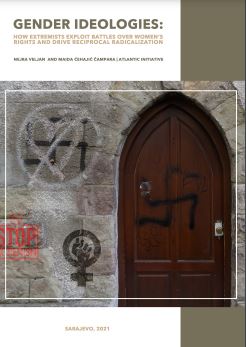
During a far-right gathering at the World Congress of Families in Italy in 2019, an ultraconservative Spanish activist declared that “this culture war is a global war. Enemies have infiltrated all institutions, from political parties to the United Nations. But the tide is turning. Now, we must launch global campaigns in the ultra-conservative fight-back, collaborating across borders. We must also seize power, directly or indirectly, by “controlling the environment” in which politicians operate.” That same year, addressing the United Nations General Assembly, UN SecretaryGeneral Antonio Guterres stressed the need to counteract the current “pushback against women’s rights”, and emphasized that everyone should be “calling out a troubling commonality in terrorist attacks, extremist ideologies and brutal crimes: the violent misogyny of the perpetrators.” Both speeches were powerful and frightening, but only one called out the enemy. Nationalist mobilization following the rise of right-wing and authoritarian regimes in Eastern and Western Europe - and throughout the world - has spawned new forms of extremist narratives gathered around traditional and religious arguments, in which gender plays a major role. Discussions around gender norms, issues, and policies can have a significant impact on political mobilization. Debates around abortion, family policies, the “nature” of women and men, sexual education in schools, gender studies in universities, and the position of sexual minorities follow political dividing lines - with the far-right occupying one end of the spectrum. We see these forces embedded in new nationalist policies and rhetoric, as well as in populist and extremist mobilization under the veil of an anti-feminist narrative. A manipulated discourse that men are under threat from efforts to establish gender equality has brought about a rise in new mannifestations of the patriarchy, coloured by nationalism, anti-immigrant rhetoric, and misogyny. Gender analyses are therefore crucial if we want to conceptualize and understand extremist groups. Such analyses can help us not only understand the underexplored intersection of gender and politics within the far-right, but also think about how the dynamics of this phenomenon might shift. After the far-right gathering in Charlottesville, USA, that resulted in Heather Heyer’s death, right-wing groups targeted their reaction against the deceased, calling her a “slut” and explicitly celebrating her death. They described Heyer as the “definition of uselessness”: to them, a childless 32-year-old woman represents a “burden on society who has no value.” Such rhetoric testifies to the intertwined relationship between the far-right and misogyny. It demonstrates how right-wing groups and individuals base their beliefs on male supremacy over women – especially the supremacy of white men. Protests in Croatia following the ratification of the Council of Europe Convention on preventing and combating violence against women and domestic violence (Istanbul Convention), along with Turkey’s withdrawal, and Bulgaria, Poland and Hungary’s efforts to distance
More...
The wars of the 1990s in the former Yugoslavia have had severe and longterm consequences, which Montenegro too still faces today and only to a limited degree. Also, almost all states of the former Yugoslavia face the challenge of addressing systemic violations of human rights, which is reflected in the process of building functional democratic institutions that should establish a responsible attitude towards the recent violent past. Such a relationship is inconceivable without establishing the truth about the fate of persons who are still listed as missing due to the armed conflicts of the 1990s. The states of the region continue to owe the families of 9,969 missing persons a full and impartial investigation into the circumstances under which their loved ones were killed or went missing, and they fail to carry out responsible sentences in accordance with the gravity of the crime committed. In Montenegro, the legislative framework does not recognize the families of persons considered missing as civilian victims of war, whereas the system of reparations is flawed and discriminatory. Given the recorded activities of Montenegro in the armed conflicts during the 1990s, as well as the court-established facts indicating the role of Montenegrin citizens in these events, a proactive approach by Montenegrin institutions is crucial in determining the fate of missing persons. Victims’ communities have high expectations from these institutions, which is proportional to the participation of the armed forces under the direct or indirect control of the state of Montenegro in the waged wars. Unfortunately, the disproportionate commitment of Montenegrin decision-makers and institutions to this issue remains. The process of searching for the missing is difficult and conditioned by the political situation in the countries of the region. Although the need to find out the truth about the fate of persons who disappeared during the armed conflicts is expressed, above all, among their family members, and sporadically appears on the agenda of meetings of statesmen in the region, in practice, there are obstacles to the search for missing persons. These obstacles range from the inadequate capacities of state bodies involved in the search for missing persons, through insufficient financial resources, to a lack of political will to substantially improve regional cooperation, which also includes the determination to make the search for missing persons more efficient. In general, there is not enough information on this issue in Montenegro, and it is also marginalized in public discourse. Therefore, this publication, as an alternative report, offers an overview of international standards and national legislation, reviewing the results and challenges of the search for missing persons during the armed conflicts in the former Yugoslavia in the 1990s, but also proposes recommendations for improving efficiency in this area.
More...
After six months of war, Ukraine can celebrate success – due to the mobilisation of its entire population to fight, and to unceasing reconnaissance and logistics support from the West, it continues to successfully defend itself. Russia, in turn, has failed to attain its initial objectives, including the “denazification” and “demilitarisation” of Ukraine and the intention to seize control of the country. The armed confrontation has already lasted far longer than the Kremlin had anticipated, which suggests that the first six months of war can be viewed from Russia’s perspective as a failure. Since the end of March 2022, when Russia decided to withdraw its troops from northern Ukraine and from portions of Mykolaiv Oblast, and when a frontline was formed in the south and in the east, Russian aggression has shifted from a phase of manoeuvre warfare to that of trench warfare. Since then, the strategic situation has not changed significantly and remains largely static. However, Russia continues to possess the initiative and any changes happening at the front are the consequences of its actions. The aggressor’s troops have maintained a relatively stable land bridge with Crimea and are slowly pushing the Ukrainian army back from its positions in the Donbas, which continues to be the main area of fighting. For the time being, the counter-offensive announced by Kyiv continues to form part of an information strategy aimed at boosting the defenders’ morale. Ukraine continues to lack sufficient manpower and adequate means, i.e. mainly heavy weaponry of an offensive nature, to attempt to recapture the occupied territories.
More...
Although 100 days have passed since the start of the Russian invasion of Ukraine, Moscow has not achieved even the hypothetical minimum objective of the operation: the capture of the entire Donbas. The fierce Ukrainian resistance and Western support for Kyiv mean that, despite the concentration of forces in selected sections, the Russian army’s progress is slow, and being paid for with high losses. However, the Kremlin has still not decided on a serious escalation of the conflict, whether by declaring general mobilisation, using weapons of mass destruction, or moving the conflict beyond Ukraine’s borders. These scenarios, although they cannot be completely ruled out, seem unlikely today. Rather, Russia is limiting (albeit probably temporarily) the scale of its ambitions for territorial gains in Ukraine, and is striving to reach lines that could create the appearance of victory and the achievement of the formal objectives of its ‘special operation’. Above all, however, the Kremlin now proclaims and believes that the current situation is merely an episode in a long-term war with the West as a whole. Accordingly, it is attempting to conduct economic and humanitarian aggression, and seeking to maximise the costs on the part of both Ukraine and the West that supports it. At the same time, it hopes that their resilience has clear limits and will ultimately force them to make political concessions to Moscow, which will bring a needed pause allowing Russia to prepare for the next stage of confrontation.
More...